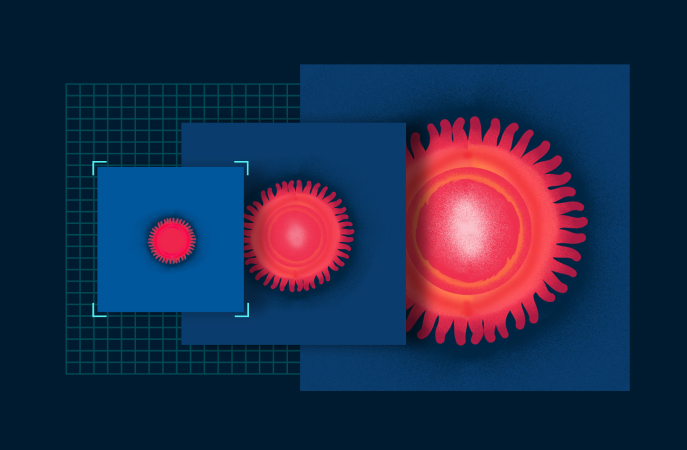All about lung nodules
The American Lung Association defines a lung nodule as a small mass of dense tissue on the lung.1 Lung nodules, also called pulmonary nodules, are smaller than 3 cm,2 which is about the size of a half dollar. If the area is larger than 3 cm, doctors call it a lung mass.2
Your care journey
A nodule can show up on chest X-rays and CT scans as a spot or a shadow.3 Nodules in the lungs are common. They appear on the scans of about half of adults who have a chest CT.4 Perhaps the most important thing to know is that about 95% are benign (not cancer).

What causes lung nodules?
Many things can cause benign lung nodules to form, including infections, inflammation, and scarring.4 The chances of a nodule being cancerous are increased if:5
- You’re older than age 65.6
- You have a history of smoking.
- You have a personal history of cancer.
- You have a family history of lung cancer.
- You received radiation therapy to the chest.
- You were exposed to asbestos, radon, secondhand smoke, or known cancer-causing agents found in some workplaces.
When are lung nodules found?1
Lung nodules are found during imaging tests, such as a CT scan or a chest X-ray. You could have one of these scans for several reasons:
- As part of a lung cancer screening for patients at high risk
- To determine the cause of symptoms you are experiencing, such as an unexplained cough
- For an unrelated health condition that requires imaging of the lungs or a nearby area
Does a lung nodule’s size matter?
Both the size of the nodule and how fast it grows can help doctors determine if further testing is needed. The likelihood of cancer is very low in nodules less than 5 mm (about the size of a pencil eraser).7 As the size increases, so does the possibility of cancer.
Doctors also look at something called “doubling time,” which is how long it takes for a nodule to double in volume.7 Benign nodules don’t grow much, but cancer cells divide uncontrollably,8 causing nodules to grow quickly. In general, cancer nodule doubling times range from 20 to 400 days.9

Does the location of a lung nodule matter?
Lung cancer nodules or masses can develop anywhere in the lung, but doctors are more concerned when they’re located in an upper lobe.9 Adenocarcinoma, the most common type of lung cancer, often develops in the outer area of the lungs, called the periphery.10,11
When should I worry about a lung nodule?
Worry is a natural response to learning you have a lung nodule, but since less than 5% of lung nodules are cancer, there’s seldom cause for fear. Doctors may want to take a closer look if a nodule has an irregular shape, spikey edges, or blood vessels moving toward it.7,9 They also look at the surrounding lung tissue and lymph nodes to see if the nodule is causing changes.
There are many tools doctors can use to determine if the nodule requires testing for a diagnosis. Let your healthcare team know how you’re feeling and ask questions to better understand what’s next. You can download the Doctor Discussion Guide for a list of questions that may help you prepare for your conversation.
What happens after a lung nodule is found?1,4
Once a nodule is discovered, you’ll most likely be referred to a pulmonologist (a doctor who specializes in diseases of the respiratory system). Your doctor will discuss their findings and potential next steps based on the size, shape, and location of the nodule. You may need additional tests, such as:
What is a lung biopsy?
A lung biopsy is a procedure where your doctor obtains a small sample of lung tissue from the nodule and looks at it under a microscope to see if cancer or another disease is present.12
When should I have one?
our doctor will consider several factors when deciding if you should have a lung biopsy. Your risk factors for lung cancer, as well as the size and shape of the nodule, will be key.
- Lung Nodules (Pulmonary Nodules). American Lung Association. 8 May 2024.
- Bankier AA, MacMahon H, Colby T, et al. Fleischner Society: Glossary of Terms for Thoracic Imaging. Radiology. 2024;310(2):e232558. doi:10.1148/radiol.232558
- What is a Lung Nodule? [PDF] Patient Education Information Series. American Thoracic Society. Web. Accessed 8 May 2024
- Pulmonary Nodules. JAMA Patient Page. Walter K. Pulmonary Nodules. JAMA. 2021;326(15):1544. doi:10.1001/jama.2021.12319
- Lung Cancer Risk Factors. American Cancer Society. Web. 8 May 2024
- Key Statistics for Lung Cancer. American Cancer Society. Web. 8 May 2024
- Larici AR, Farchione A, Franchi P, et al. Lung nodules: size still matters. Eur Respir Rev. 2017;26(146):170025. Published 2017 Dec 20. doi:10.1183/16000617.0025-2017
- What Is Cancer? National Cancer Institute. Web. 8 May 2024
- Gould MK, Donington J, Lynch WR, et al. Evaluation of individuals with pulmonary nodules: when is it lung cancer? Diagnosis and management of lung cancer, 3rd ed: American College of Chest Physicians evidence-based clinical practice guidelines. Chest. 2013;143(5 Suppl):e93S-e120S. doi:10.1378/chest.12-2351
- What Are the Types of Lung Cancer? American Lung Association. 8 May 2024.
- What Is Lung Cancer? American Cancer Society. Web. 28 June 2024
- Lung Cancer - Non-Small Cell: Diagnosis. American Society of Clinical Oncology (ASCO). 8 May 2024


